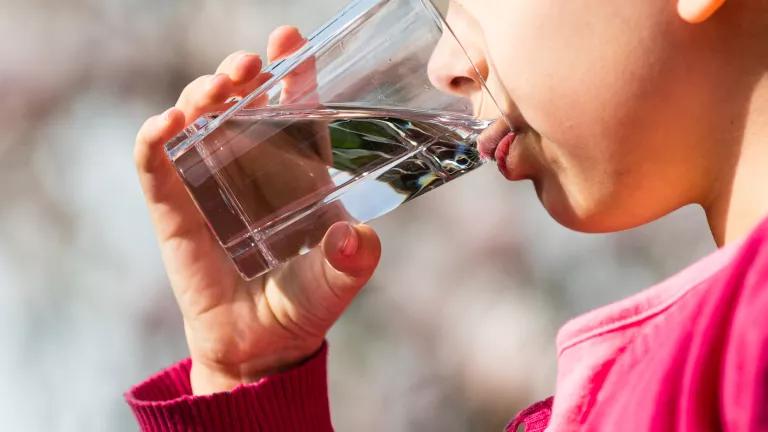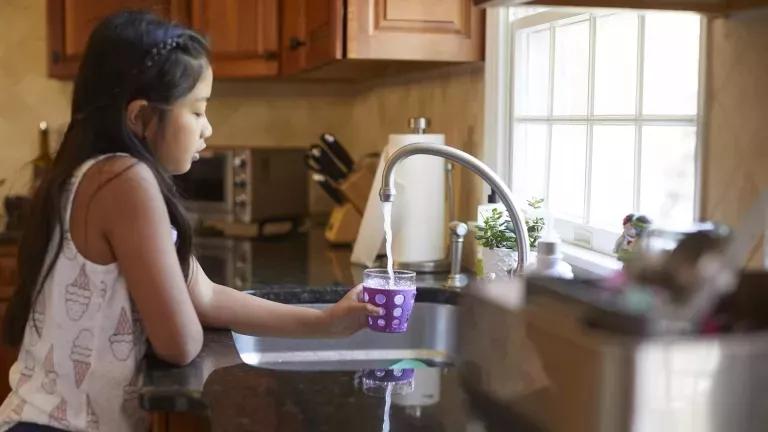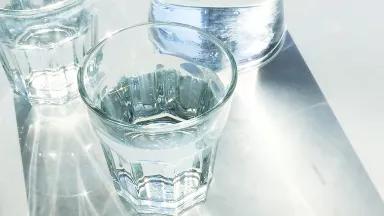
Safe drinking water is something we Americans tend to take for granted, until a crisis like lead contamination in Flint, Michigan, makes us wonder what chemicals could be lurking in our own taps.
“Flint was a wake-up call for Americans, but it’s not the only place in the United States with tap water problems,” says Erik Olson, senior strategic director of NRDC’s health and food team. “Thousands of other cities and small towns across the country are serving water with lead or other contamination problems to millions of people.” NRDC has fought to protect drinking water—both locally and nationally—for decades. In fact, Lynn Thorp, national campaigns director for the nonprofit organization Clean Water Action, says NRDC has been the group’s most valued partner in efforts to enforce the federal Safe Drinking Water Act (SDWA). “Together we’ve been a watchdog for the public at every stage of implementation and for all the many parts of the law,” she says.
While there have been victories over the years, you should still remain vigilant about the contaminants that might be in your pipes, faucets, or local water supply. Here’s what you should know and how you can stay safe.
Contaminants in drinking water
It's not just about lead. All public water suppliers in the United States are required to uphold certain levels of water quality. As long as these requirements are met, Olson says, most Americans can drink their local tap water without worry. Still, violations remain widespread, and some water systems have contaminants that aren’t regulated by the U.S. Environmental Protection Agency.
According to an NRDC report, nearly 77 million Americans got drinking water from systems that violated federal protections in 2015, and more than a third of this number relied on systems that did not comply with standards put in place to protect health. Millions of other Americans’ water suppliers failed to test water safety properly or didn’t report test results to health authorities or customers—potentially sweeping many more health risks under the rug.
These numbers likely understate the extent of the problem, given underreporting and the fact that many contaminants aren’t even monitored or regulated. For instance, common contaminants such as perchlorate and PFOA/PFOS (chemical cousins of Teflon) occur in millions of Americans’ tap water, but because they aren’t regulated by the EPA, they don’t show up in these already staggering figures.
Sensitive groups, like pregnant women and children, are at higher risk for health complications, especially from the following contaminants:
Lead
Likely the most famous bad guy, this heavy metal can leach from lead pipes and plumbing fixtures, especially when the water flowing through them is corrosive. It can cause neurological and behavioral problems in children and adverse health effects in adults. “It’s a more common problem in cities with older water systems,” NRDC scientist Kristi Pullen Fedinick says, “but what a lot of people don’t realize is that even relatively new brass fixtures and faucets can still contain significant amounts of lead. Just because your home is less than 20 years old doesn’t necessarily mean you’re lead-free.”
PFAS
These health-harming “forever chemicals,” which seep into our groundwater from landfills and are dumped by industries directly into waterways, contaminate water systems in all 50 states. PFAS (which stands for per- and polyfluoroalkyl substances) have been linked to cancer (kidney and testicular), hormone disruption, liver and thyroid problems, interference with vaccine effectiveness, reproductive harm, and abnormal fetal development. The EPA’s PFAS Strategic Roadmap will increase research into health impacts and aims to limit pollution, including lead in drinking water. Meanwhile, NRDC and our partners are continuing to push the federal government to phase out the full class of more than 12,000 toxic chemicals, while simultaneously urging states to adopt a standard maximum contaminant level.
Atrazine
This endocrine-disrupting chemical is one of the most commonly detected pesticides in U.S. waters. NRDC studies have found its contamination is most common in drinking water across the Midwest and the southern United States. The EPA currently monitors a sample of community water systems to determine if atrazine concentrations pose a risk to public health, but NRDC has called on the government to phase out the use of this chemical entirely.
Pathogens
Bacteria, viruses, and parasites that cause illness can find their way into water supplies that are inadequately treated to kill germs. Fortunately, these pathogens are much better controlled today than they once were. After a 1993 waterborne-disease outbreak in Milwaukee sickened more than 400,000 people, Olson says, “NRDC really led the charge in changing the EPA’s rules and safeguards.” But clearly much more remains to be done.
Chlorine treatment by-products
Chemicals used in drinking water’s disinfection process, such as trihalomethanes and haloacetic acids, may cause cancer and reproductive problems if present in high quantities.
Arsenic
The EPA estimated in 2000 that nearly 36 million Americans drank water containing arsenic at or above 3 parts per billion—the level NRDC had urged be established as a drinking water standard. “The EPA had delayed and delayed updating the arsenic standard that was originally issued in the 1960s, but we finally got them to relent and update the arsenic number based on modern science in the early 2000s,” Olson says. Since then, arsenic levels across the country have declined as a result, he adds, but the contaminant is still worth looking out for.
Nitrates
Though nitrates occur naturally in plants and soil at low concentrations, they have become a widespread contaminant due in part to their use as fertilizer. Runoff from factory farms flows into surface and ground water and ends up in our drinking water. The EPA set a limit of 10 parts per million for nitrates, which can be harmful to pregnant women and infants. In rare cases, exposed infants can develop blue baby syndrome, a potentially fatal illness that prevents the blood from carrying oxygen.
Radioactive contaminants
Most radioactive elements found in drinking water occur naturally, but radioactive material from the production of nuclear weapons, energy, and medicines can also get into drinking supplies through leaks or improper waste storage. Exposure can cause cancer or kidney failure.
Vinyl chloride
Used to make PVC plastic products, such as some pipes, this cancer-causing contaminant can leach from older PVC piping and has been found in the drinking water of a small number of communities across the country.
Perchlorate
This widespread toxic chemical, used in rocket fuel, explosives, and road flares, can interfere with thyroid hormone production. Perchlorate has been detected in the water in at least 26 states, yet there is no federal standard for its presence in drinking water. In 2011, after more than a decade of pressure from environmental and health groups led by NRDC, the EPA announced that it would set such a standard—but it still hasn’t even proposed a rule for the contaminant. After NRDC filed a lawsuit against the EPA for its failure to act in the time frame allotted by the Safe Drinking Water Act, the agency committed in a consent decree in late 2016 to get a proposed perchlorate standard out in 2018 and a final standard by 2019.
Pharmaceuticals
Prescription drugs enter our water supply when patients release traces in their urine or flat-out flush unused medication down the sink or toilet. NRDC has petitioned the FDA to pay more attention to medicines making their way into the environment, and a 2010 NRDC report provided recommendations for reducing the flow of these drugs into our waters.
Frequently Asked Questions
My water system has violated federal drinking water standards. What should I do?
If you get your drinking water from a public system, start by checking the annual water quality report (sometimes called a consumer confidence report) published by your water supplier. It’s usually mailed once a year with your water bill and should also be available online. The report summarizes which contaminants have been found in your drinking water and whether any of them have reached potentially dangerous levels. Your supplier is also required to send out public notifications if any of these levels violate health and safety standards. You may also visit the EPA’s Safe Drinking Water Information System (SDWIS) search page to look up your water system’s compliance history.
If you suspect you have lead pipes or fixtures, if you get your water from a private well, or if you notice a change in your water’s taste, color, or clarity, Olson recommends having your water tested for contaminants. Your water supplier may do free in-home testing, or you can ask a certified lab to test your water. Call the Safe Drinking Water Hotline at 800-426-4791 to find a state-certified lab in your area. You can also order a test for lead in your water from the nonprofit Healthy Babies Bright Futures, which lets you choose how much you can pay.
Then install an NSF-certified faucet filter or whole-house filter that is certified to remove the contaminants you’re concerned about. To find the right filter, check off the contaminants you’re concerned about under “Reduction Claims for Drinking Water Treatment Units―Health Effects.”
If your water system seems to be having frequent or serious violations, call your elected representatives or state drinking water program to demand action, or report the problem to the EPA’s Safe Drinking Water Hotline (800-426-4791).
My water was tested and it contains high lead levels. What should I do?
First and foremost, install filters that are NSF-certified to remove lead. Then follow these tips:
- If the water hasn’t been used for several hours, run it for at least five minutes on cold before you consume it.
- Use only cold water from taps for drinking and cooking, as warmer water is more likely to contain higher levels of lead (and boiling water can actually increase lead levels).
- Remove and rinse out the aerator, the little screen on the end of your faucet, every week or so.
I have contaminated water and a vulnerable immune system. What should I do?
For people whose immune systems have a lessened ability to defend against illness—such as pregnant women, the very young, the elderly, those on cancer chemotherapy, and those living with AIDS—the Centers for Disease Control and Prevention recommends the following:
- Boil water for drinking, cooking, or making infant formula (unless your water contains elevated levels of lead or arsenic); or
- Drink bottled water that has been treated by reverse osmosis, distillation, or filtration with an absolute 1 micron (or smaller) filter.
Should I just buy bottled water?
Bottled water may be a useful short-term source of drinking water in emergencies, but it shouldn’t be a permanent solution because it is not necessarily cleaner or safer than tap water. As mentioned above, if you do buy bottled, look for brands that have been treated with reverse osmosis, distillation, or filtration with an absolute 1 micron (or smaller) filter.
My water system is not listed as having violated any health-related drinking water standards. Does that mean I'm safe?
For many systems—especially large systems that serve more than 100,000 people—you may be safe. However, there are weaknesses in the rules themselves. For example, many fairly common contaminants (such as perchlorate, PFOA, and algal toxins) are not federally regulated, so there would be no violation of EPA rules if they are found in your water. Also, the rules about how often to monitor water may mean that spikes in contaminants between tests go undetected. Additionally, local officials could try to avoid submitting health-based violations to the state or the EPA, might not report samples showing violations, or might not take samples in the first place. For peace of mind, have your water tested.
Who can I talk to about my concerns regarding the quality of my drinking water?
Contact your water utility, your city council members, and your mayor. Express your concerns. Urge them to fix the problems and keep you informed about their progress. Contact your state and federal legislators and ask them to support funding for water infrastructure improvement projects.
This NRDC.org story is available for online republication by news media outlets or nonprofits under these conditions: The writer(s) must be credited with a byline; you must note prominently that the story was originally published by NRDC.org and link to the original; the story cannot be edited (beyond simple things such as grammar); you can’t resell the story in any form or grant republishing rights to other outlets; you can’t republish our material wholesale or automatically—you need to select stories individually; you can’t republish the photos or graphics on our site without specific permission; you should drop us a note to let us know when you’ve used one of our stories.
Millions of Americans drink tap water served by toxic lead pipes.
Tell the EPA we need safe drinking water!

Tell the EPA we need safe drinking water!
There is no safe level of lead exposure. But millions of old lead pipes contaminate drinking water in homes in every state across the country. We need the EPA to do its part to replace lead pipes equitably and quickly.




“Forever Chemicals” Called PFAS Show Up in Your Food, Clothes, and Home
How to Find Out If Your Home Has Lead Service Lines
How to Protect Yourself from Lead-Contaminated Water